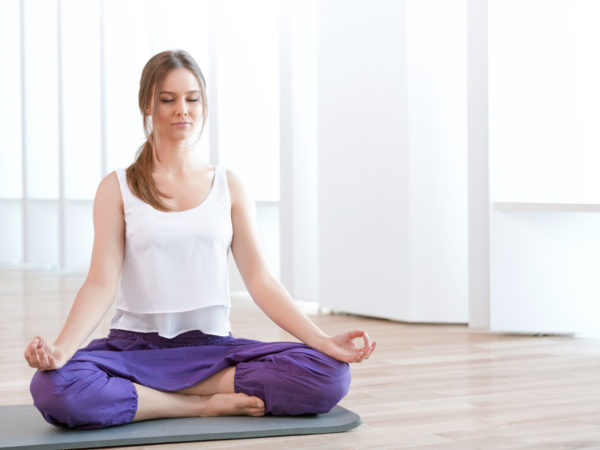Lotus Pose

“The Lotus Pose provides the opportunity to relax and focus on the mind-body connection. Ultimately, one may come to see that divisions between body, mind and spirit are illusions. – Andrew Weil, M.D.
Description & History
Lotus Pose is one of the most easily recognized yoga poses. Legs crossed and hands resting on knees with thumb and index finger forming a circle, it is a popular pose to perform. The Lotus Pose, known in Sanskrit as Padmasana, comes from padma meaning lotus and asana meaning posture. The pose is often used as a resting pose to calm the mind and body as well as focus on controlled breathing. It also stretches the muscles of the hips and back.
How to Perform Lotus Pose
- Begin by sitting on the floor with your legs out in front of you.
- Exhale and bring your right foot in toward your body, placing it on your left thigh. Do the same with your left foot by sliding it under your right leg and placing it on your right thigh.
- Place your hands on your knees with palms facing up. Relax your hands and touch together the tips of your index finger and thumb to create circle.
- Press your sitting bones into the floor and reach the top of your head to the sky. Slow your breathing and focus on relaxing your mind.
- Stay in this pose for 30 seconds to one minute. Come out of the pose and repeat with the other side.
Potential Health Benefits
- Stretches and opens the hips and groin
- Provides breathing and meditation benefits for relaxation
- Stimulates abdominal organs
- Eases menstrual discomfort
- May ease childbirth in pregnancy
The Lotus Pose is considered a meditative pose and is often used for relaxation. Researchers included the Lotus Pose in a study with other yoga poses to examine the health effects on sleep quality and quality of life in elderly people. The study was published in the Journal of Ayurveda and Integrative Medicine and showed practicing yoga poses, including the Lotus Pose, can improve both sleep quality and quality of life.
Modifications & Variations
Beginners trying the Lotus Pose may find it difficult to sit with both feet on top of the thighs. There are two modified versions of the Lotus Pose you can perform to still experience some of the benefits it provides. One modification is to perform the Half Lotus Pose (Ardha Padmasana) where one foot is on top of the opposite thigh while the other is under the other thigh. Switching to the other leg provides stretching benefits for both legs without going into the full Lotus Pose. A second modification is to perform the Easy Pose by sitting cross-legged with hands on the knees and palms facing up. Relax your hands and form a circle with your index finger and thumb. While a different pose, it provides similar breathing and meditative benefits.
For advanced practitioners, go into the Lotus Pose and lift your chest while extending your neck and head toward the ceiling. Slowly lean back from your hips until your head touches the floor. Swing your arms over your head and rest them on the floor. Hold this pose for 30 seconds to one minute. Once you are ready, bring your torso up by starting with your chest, keeping the head back.
Precautions
If you experience pain in your hips, knees, or ankles, follow one of the modified versions of the Lotus Pose in the prior section or avoid the pose altogether.
Related Poses
- Standing Forward Bend (Uttanasana)
- Child’s Pose (Balasana)
Reviewed by: James Nicolai, M.D., on August 20th, 2013.
Sources
Bankar, Mangesh A., Sarika K. Chaudhari, and Kiran D. Chaudhari. “Impact of long term Yoga practice on sleep quality and quality of life in the elderly.” Journal of Ayurveda and integrative medicine 4, no. 1 (2013): 28.









